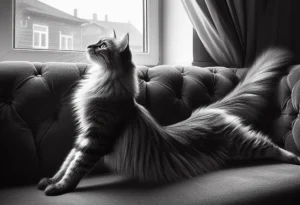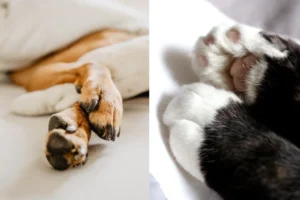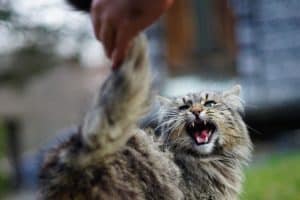Cats are known for their sleek bodies, sharp claws, and captivating eyes. But have you ever stopped to wonder why their tails are so incredibly long? Let’s find out the reasons behind this feline feature.
Cats’ tails serve multiple purposes, from aiding in balance to communicating emotions. Here’s a breakdown of why these mysterious appendages are longer than you might expect.
Evolutionary Advantage
Cats’ long tails have evolved over time to give them a remarkable advantage in various situations. One key reason for their tail length is the role it plays in communication. Cats use their tails to express emotions and intentions. For example, a tail held high indicates confidence, while a fluffy tail signals agitation or fear.
Furthermore, evolution has favored cats with longer tails for their exceptional balance. This is particularly crucial for cats who are skilled hunters. Their tails act as a counterbalance, allowing them to make precise movements and navigate tricky terrains with ease. Long tails also help cats to adjust their body’s center of gravity, ensuring they can sprint, jump, and pounce with accuracy.
Unique Insight: In some wildcat species, such as the cheetah, the tail also functions as a stabilizer during high-speed chases, enabling them to maintain their speed and agility.
Balance and Agility
Cats rely heavily on their tails to maintain impressive levels of agility and grace. When a cat leaps, its tail instinctively moves in the opposite direction to its body, acting as a counterbalance to ensure a landing as smooth as butter. Additionally, during precarious climbing situations, the tail aids in weight distribution, allowing cats to effortlessly navigate their way up trees or ledges.
A cat’s tail serves as a remarkable tool for communication and coordination. Through slight movements and positions, cats convey their emotions and maintain their balance with precision. Whether leaping across rooftops or stealthily stalking prey, a cat’s tail is essential for maintaining its supreme agility.
Remember, a cat’s tail is not just a cute accessory—it’s a crucial component of their anatomy that plays a vital role in their everyday life. So next time you see a cat gracefully landing on its feet after a daring jump, remember to appreciate the incredible functionality of its long, elegant tail.
Communication Tool
Cats use their long tails as a versatile tool for communication. Tail height can indicate a cat’s mood: an upright tail signals a friendly greeting, while a puffed-up tail suggests fear or aggression. Tail movement also conveys emotions: a flicking tail may show annoyance, while a slow swish indicates contentment. Tail wrapping around a human or another animal demonstrates affection. Understanding these tail cues helps us better connect with our feline friends.
Hunting Aid
A cat’s tail is not just for show – it’s a crucial hunting aid. During stalking, a cat’s tail stays low to the ground to maintain stealth. When preparing to pounce, the tail acts as a counterbalance, helping the cat stay agile and precise. The twitching of a tail right before a strike can signal excitement and readiness. A cat’s long tail is a silent yet powerful weapon in the art of hunting.
Additional Insight:
- An interesting behavior called “tail quivering” is often seen when a cat is intensely focused on prey. This quiver might be an instinctual response to maintain balance and focus while in hunting mode. Watching for this quiver can give you a clue that your cat is in hunting mode and ready to strike.
Temperature Regulation
Have you ever wondered why cats have such long tails? One essential reason is their temperature regulation. A cat’s tail plays a crucial role in helping them maintain their body temperature, especially in extreme weather conditions. During hot weather, cats use their tails to cool down by increasing blood flow to the skin, allowing for better heat dissipation. Conversely, in cold weather, cats fluff up their tails to trap heat close to their bodies, keeping them warm. So next time you see a cat flicking its tail, know that it’s not just for show—it’s helping them stay comfortable in varying temperatures.
Breed Variations
While all cats have long tails for temperature regulation, different cat breeds have unique tail adaptations to suit their environments and lifestyles. For example, the Maine Coon, known for its thick, bushy tail, likely developed this feature to stay warm in cold climates. On the other hand, the sleek Siamese cat may have a long, slender tail that helps with balance during its agile movements. Domestic cats often sport a medium-length tail, allowing for versatility in different situations. Understanding how various cat breeds have adapted their tails can give us insight into their evolutionary history and unique characteristics.
Unique Insight: Did you know that some cat breeds, like the Manx, are known for having little to no tail at all? This distinct trait is a result of genetic mutations rather than environmental adaptations, showcasing the diversity of feline tails across different breeds.
Fun Facts about Cat Tails
Did you know that a cat’s tail serves as a balance and communication tool? Yes, it’s true! The length of a cat’s tail is approximately equal to the length of its body. This remarkable adaptation helps cats to maintain their balance while walking on narrow surfaces and allows them to communicate their emotions through tail movements.
Another interesting fact is that a cat’s tail is composed of bones and muscles that give it flexibility and strength. This enables cats to use their tails for various purposes, such as hunting, climbing, and even expressing their mood. So, the next time you see your cat wagging its tail, pay attention as it might be trying to tell you something!
Tail Health and Care
Taking care of your cat’s tail is essential for their overall well-being. Regular grooming is important to prevent matting and tangling of the fur on the tail. Use a soft brush or comb to gently remove any debris or dirt that may accumulate on the tail.
Additionally, keep an eye out for any signs of injury or infection on your cat’s tail. If you notice any swelling, redness, or discharge, consult your veterinarian immediately. It’s also essential to ensure that your cat has a comfortable environment with safe spaces where they can move freely without any risk of tail injury.
Remember, a healthy tail leads to a happy cat, so invest time in caring for this crucial part of your feline friend’s body.
Tail Care Tips: 1. Regularly groom your cat’s tail to prevent matting. 2. Check for any signs of injury or infection. 3. Provide a safe environment to prevent tail accidents. 4. Incorporate interactive toys to keep your cat active and engaged, promoting tail health. 5. Consult your veterinarian for any concerns regarding your cat’s tail health.
By understanding the significance of a cat’s long tail and implementing proper care practices, we can ensure our beloved feline companions lead happy and healthy lives.
Alex, a passionate animal lover, has experience in training and understanding animal behavior. As a proud pet parent to two dogs and three cats, he founded AnimalReport.net to share insights from animal experts and expand his knowledge of the animal kingdom.









